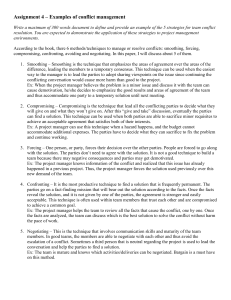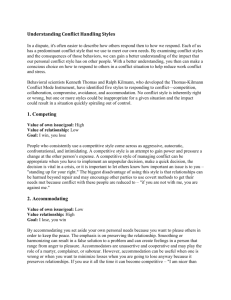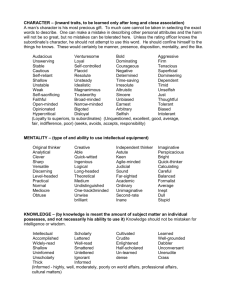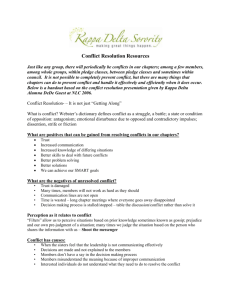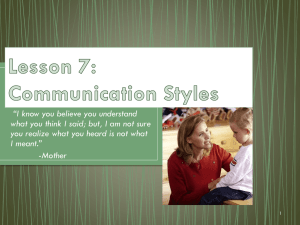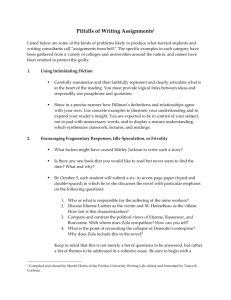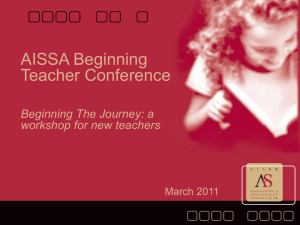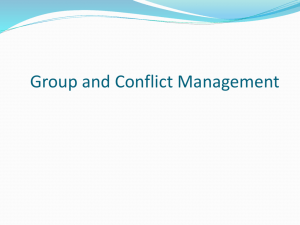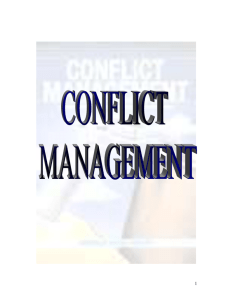Conflict Management Tools
advertisement
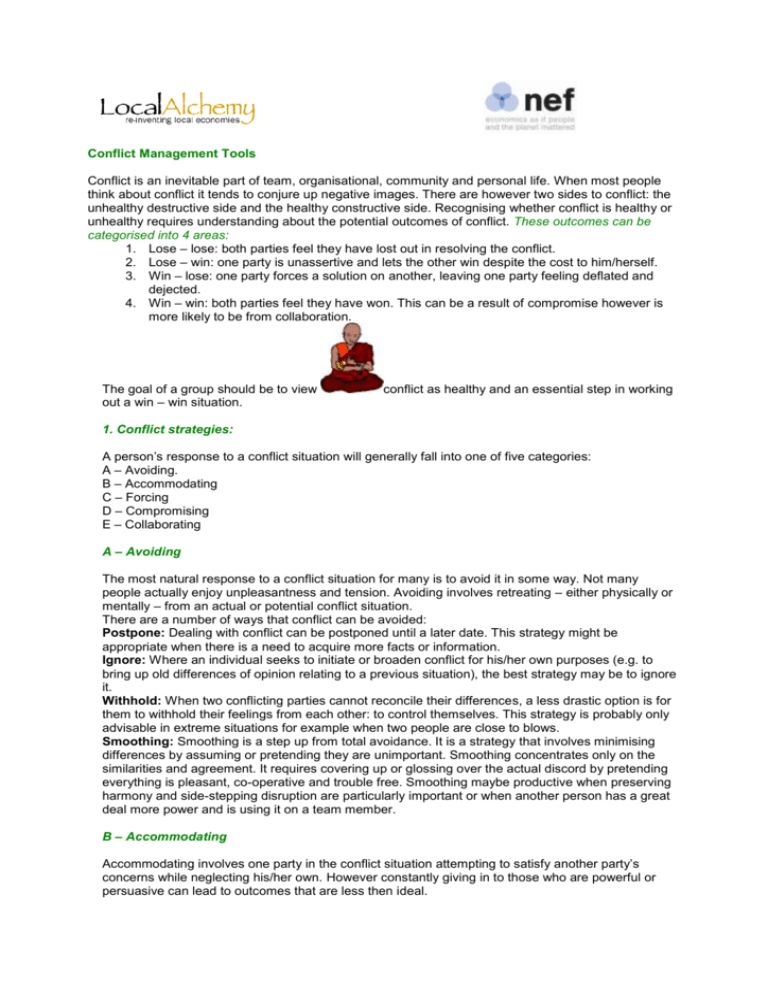
Conflict Management Tools Conflict is an inevitable part of team, organisational, community and personal life. When most people think about conflict it tends to conjure up negative images. There are however two sides to conflict: the unhealthy destructive side and the healthy constructive side. Recognising whether conflict is healthy or unhealthy requires understanding about the potential outcomes of conflict. These outcomes can be categorised into 4 areas: 1. Lose – lose: both parties feel they have lost out in resolving the conflict. 2. Lose – win: one party is unassertive and lets the other win despite the cost to him/herself. 3. Win – lose: one party forces a solution on another, leaving one party feeling deflated and dejected. 4. Win – win: both parties feel they have won. This can be a result of compromise however is more likely to be from collaboration. The goal of a group should be to view out a win – win situation. conflict as healthy and an essential step in working 1. Conflict strategies: A person’s response to a conflict situation will generally fall into one of five categories: A – Avoiding. B – Accommodating C – Forcing D – Compromising E – Collaborating A – Avoiding The most natural response to a conflict situation for many is to avoid it in some way. Not many people actually enjoy unpleasantness and tension. Avoiding involves retreating – either physically or mentally – from an actual or potential conflict situation. There are a number of ways that conflict can be avoided: Postpone: Dealing with conflict can be postponed until a later date. This strategy might be appropriate when there is a need to acquire more facts or information. Ignore: Where an individual seeks to initiate or broaden conflict for his/her own purposes (e.g. to bring up old differences of opinion relating to a previous situation), the best strategy may be to ignore it. Withhold: When two conflicting parties cannot reconcile their differences, a less drastic option is for them to withhold their feelings from each other: to control themselves. This strategy is probably only advisable in extreme situations for example when two people are close to blows. Smoothing: Smoothing is a step up from total avoidance. It is a strategy that involves minimising differences by assuming or pretending they are unimportant. Smoothing concentrates only on the similarities and agreement. It requires covering up or glossing over the actual discord by pretending everything is pleasant, co-operative and trouble free. Smoothing maybe productive when preserving harmony and side-stepping disruption are particularly important or when another person has a great deal more power and is using it on a team member. B – Accommodating Accommodating involves one party in the conflict situation attempting to satisfy another party’s concerns while neglecting his/her own. However constantly giving in to those who are powerful or persuasive can lead to outcomes that are less then ideal. C – Forcing Forcing is the opposite response to accommodating. When forcing, the individual considers only his/her own concerns and ignores those of the other party. This is sometimes done through use of cohesive power and being insistent. The person using this style is very often dominant or manipulative. This style can create private unvoiced resistance or resentment in individuals. D – Compromising Compromising, which can include arbitration, negotiation and bargaining is an attempt to provide both conflicting parties with at least a reasonably satisfactory result. Both parties are asked to make certain sacrifices in exchange for some concessions from the other – for the good of the team. Each party wins some things and loses others. Compromising is really a search for a middle ground. The watch on this one is that when used too often with a team it could be that underlying issues are being covered up and not being dealt with. E – Collaboration Collaboration is an integrative approach in which each person involved in the conflict actively seeks to satisfy his or her own goals, as well as the goals of others. Collaboration is therefore the only strategy for a win-win outcome. 2. Tools The tools listed below are to help groups when they have conflict which they want to manage in a positive and healthy manner thereby seeking a win-win situation/solutions. Continuums: They help to explore and visually rank the different views on an issue within the group. Start by creating an imaginary or real (chalk) line through the room. One end stands for “I agree completely”, the other end for “I disagree completely”. Outline the issue under debate and formulate it into a statement to agree or disagree with. Ask people to position themselves along the line according to their views. They may try out several spots before making a final choice. Ask them to have a short conversation with the person next to them, explaining why they are where they are. Then invite participants to share their viewpoints and feelings with the group. Repeat this exercise with other statements that explore the issue and see how people’s viewpoints change. You could also use a curved line so that people can see each other. This exercise taps both into our intuitive and rational sides and needs to be done quietly and thoughtfully. This exercise requires strong facilitation to stop the group from slipping into general discussion. When views and discussion have been heard and everyone has had their say see if anyone is prepared to move in light of what they have heard. Then enter into dialogue and explain that the point of this next session is to find solutions to issues and to work together to find ways of getting people to move closer together. Ask what would it take to get you to move two spaces type questions. Hassle lines: This tool is similar to role play however it allows the whole group to be involved at the same time as well as making people feel more comfortable, because they are not put on a stage like in a role play. It is very useful for preparing everyone rapidly for a particular situation. Think about situations that might arise. Choose one conflict situation and define the two sides. Form two rows of people standing opposite each other, so that each individual on one side stands opposite another person in the other row. The left row for example may take on the role of protesters, the other side of unsympathetic passers-by, making a provocative comment such as get a job, you dirty hippy. Each pair then plays through dealing with the conflict. After a few minutes the exercise is stopped and all the different pairs share with the group how they dealt with the conflict, how it worked and how it made them feel. Sides can then be swapped around. You can also try getting people in each row to link arms to create a stronger group identity - how does this affect people’s ability to deal with conflict individually? Repeat the exercise choosing other conflict situations. Think and listen - Pairs: This tool creates a space where we can be confident that we will be heard. It enables participants to explore and formulate their own thoughts/feelings on an issue without interruption but with the knowledge that they are being listened to. It also encourages active listening. It is very useful in uncovering and resolving conflict. It also allows people to gather and consolidate their thoughts before a group discussion. Split into pairs, one person is the listener, the other the thinker. The thinker speaks about her thoughts/feelings on the issue. She/he may also be quiet or laugh. Encourage the thinker to speak first thoughts - that is to speak as thoughts enter his/her mind without analysing or holding back. This may seem difficult at first - think of it as holding an internal monologue, but loudly. The role of the listener is to give her/his full attention to the thinker without interrupting, questioning or commenting. The listener should provide an attentive supportive atmosphere through eye contact, body language, encouraging noises, smiles and nods. If the thinker gets stuck the listener may ask neutral questions such as how does that make you feel? Why do you think that? After a set time (5 minutes is usually plenty of time) thinker and listener swap roles. Using process to solve the problem: Use a five step process to understand and resolve the conflict. 1. Clarify the existing positions and associated interests. Do this with everyone speaking or capturing how they feel as an individual. Ask people to summarise their position in maximum of 12 words. Ask each person to capture their thoughts then listen as each person gives their input. Capture each position on the left hand side of a flipchart putting ones together if they are the same or similar. Restrict discussion this is a giving once only for each person. Now ask people to think about their interests and what they hope to achieve by taking the position they have. Again using minimal words capture each persons interests on the right of the flipchart. 2. Define the areas of agreement. Ask everyone to look at the positions and interests and identify any shared common interests. This will help to start collaboration. It shows that the situation is not hopeless. Complete a separate list on a flipchart of areas of agreement. 3. Define the areas of disagreement. Complete a separate list of the differences. The below questions can be useful at this stage to identify for each area of disagreement what the point of contention is. Goals – is there conflict over what end results the group are trying to achieve. Roles – is there conflict over who should or can do what. Procedures – is there conflict over the strategies, methods or tactics used for doing something. Relationships – is there conflict over how people relate to each other. Limits – is there conflict over what is or isn’t possible and what level of power the group have. Timing – is there conflict over when something will be achieved. Information – is there conflict over facts, figures or data being used. Values – is there conflict over what is right, wrong, fair, ethical or moral. Using these questions will help clarify the actual problem that is faced. 4. Get the whole team to view the areas of disagreement as a shared problem to be resolved. This is a short stage where the facilitator has to get the group to see that to move on they need to jointly own and solve the problems. 5. Take measures to resolve the areas of difference. Now it is time to generate options for solving the problems and getting mutual gain. Ensure no idea is overlooked. Make sure no-one is left out of the session and that everyone contributes. Use the idea generation tools from the toolkit. Hold a session to get peoples views on the ideas and potential solutions they like – could vote here. Develop the favourite ideas into solutions. When people are giving their views about ideas or solutions have a rule that they can only raise concerns if they say what they like about an idea or solution first.
